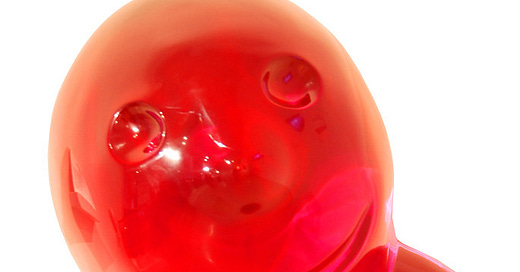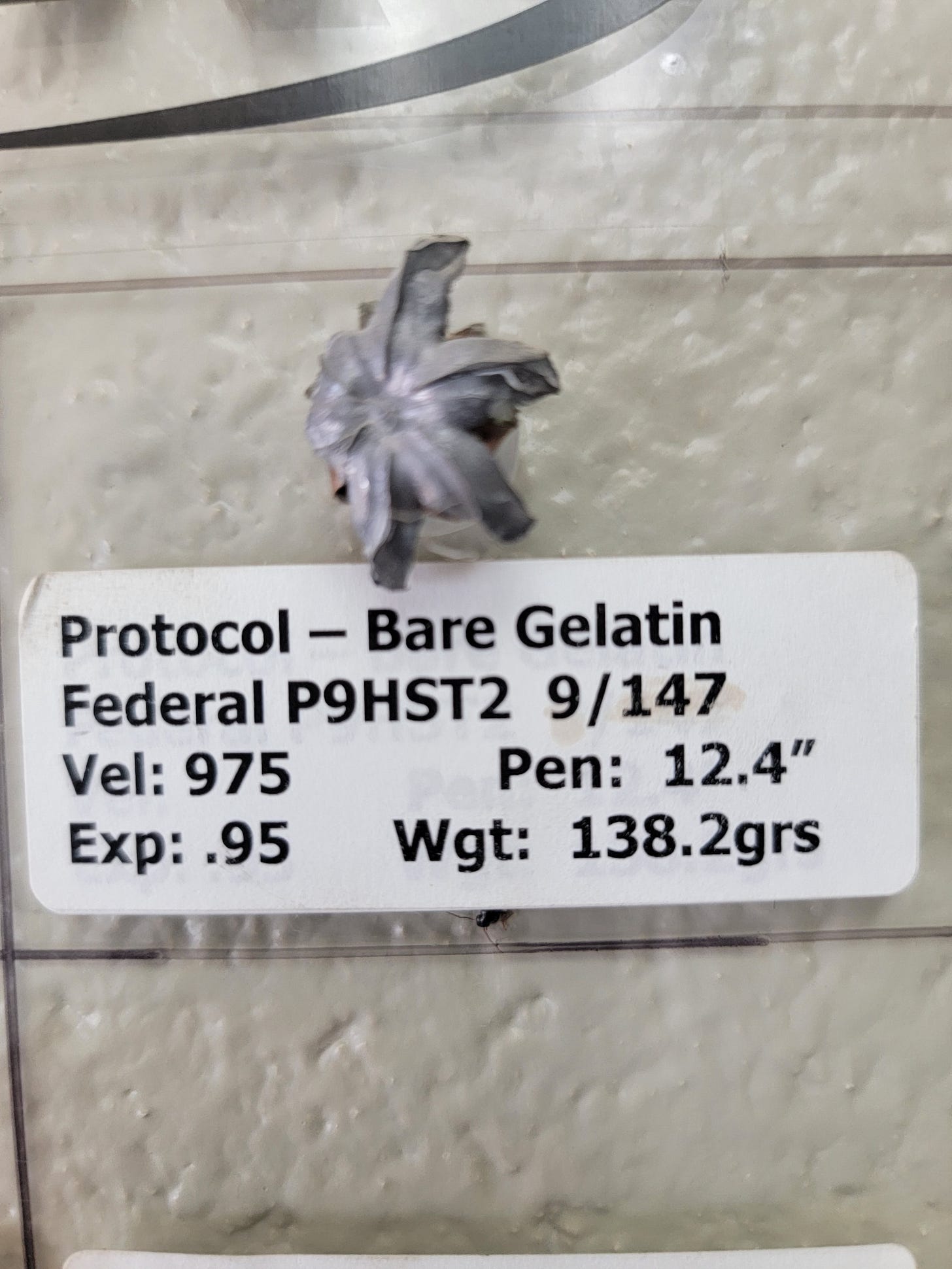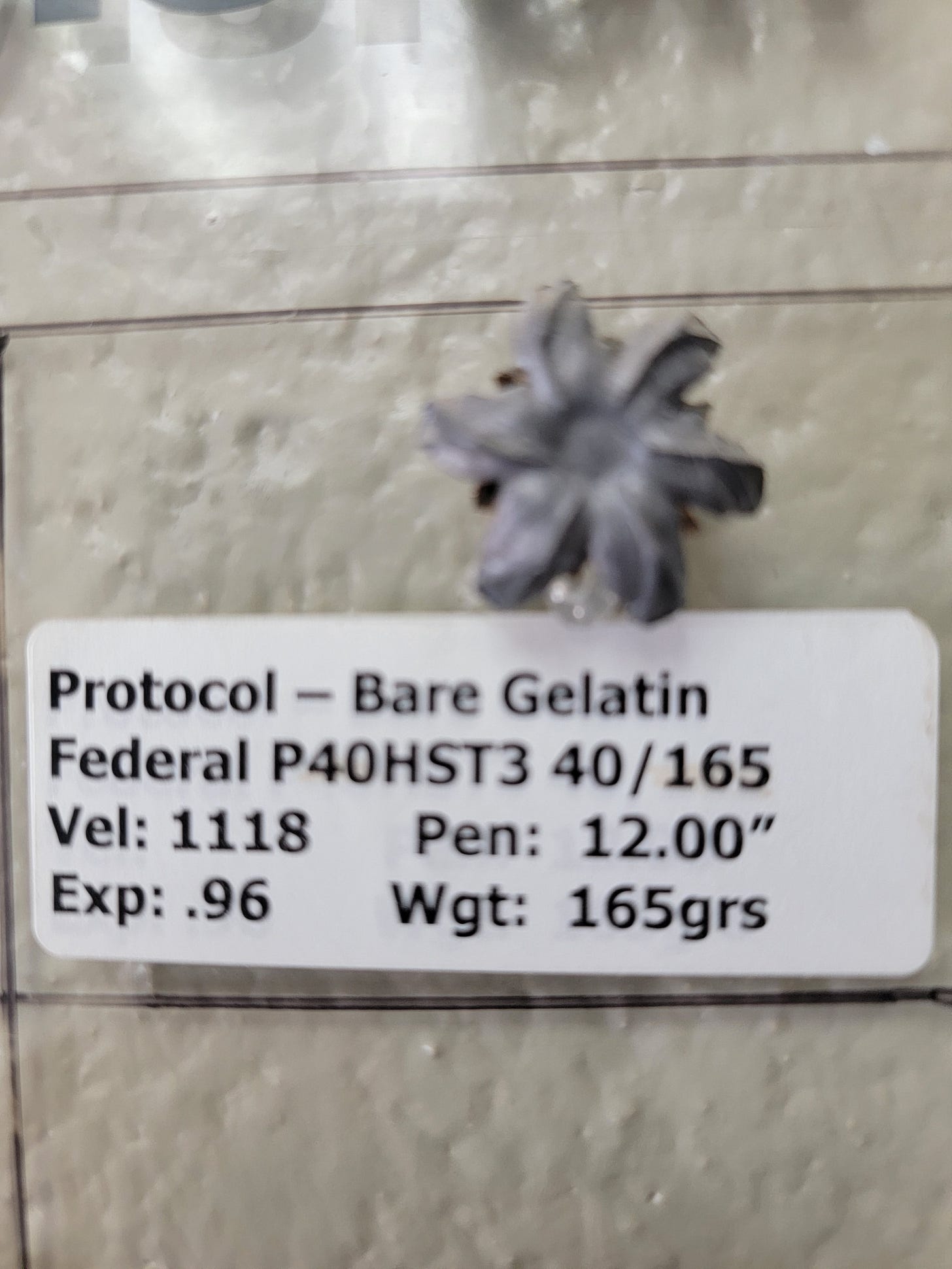Settle in, boys and girls - this is gonna be a long one.
Ballistics. I don’t know of many topics in the gun community that don’t at least touch tangentially on this subject, and that are as fraught with argument. The You-tubes is full of backyard exspurts showing their “testing,” and giving their opinion on this subject. Made up/meaningless terms abound. “Scientists” use sock accounts on forums, and edit Wikipedia to give traction to debunked theories. Anecdotal, unsubstantiated stories are offered up as “proof.” Actual science is mocked. It’s kinda crazy.
Entire treatises can be written on the subject, but I’m an idiot so I’m gonna dumb things waaaay down.
Let’s start with some basic facts:
If it is marketed for defensive use, and it’s in America, it is designed to meet FBI Protocol testing. Doesn’t matter what caliber, the metrics the manufacturer are trying to meet come from the Protocol. At least if they want to make money.
What this means, is if it is a common self defense or duty caliber, the caliber you choose will have very little impact on the effectiveness of the round. Because, regardless of caliber, manufacturers are designing and producing rounds that all meet the same performance metrics.
A good writeup on FBI Protocol testing:
https://brassfetcher.com/FBI%20Ammunition%20Protocol/FBI%20Ammunition%20Protocol.html
Science is based on reproducible data. To be reproducible, testing must be consistent, as must the outcome.
We get this reproducible data by conducting testing in the exact same way, removing variables as much as possible. Thus, why we use properly callibrated 10% porcine gel, and a protocol. Not groceries in the backyard.
Ballistic gelatin is not meant to be an analog to the human body. It is, however, fairly close to living human muscle tissue in the way it reacts to bullets.
Also, actual autopsy data shows that real world performance is closely matching the larger data set from testing. If it performs well in testing, it seems to be performing well in actual shootings.
Shooting pigs/dogs/deer/etc is also not analogous to performance in humans. Even shooting human corpses would not be a proper analog as the moment death occurs, changes in the tissue begin.
Muscle density, skeletal design, amd the nebulous psychological components that relate to shootings make one for one comparisons difficult, particularly across species.
Ballistic gelatin is not all the same. For FBI Protocol testing, the ingredients, preparation, and storage of the ballistic gelatin is highly regulated. Clear gelatin that is available for purchase has been shown to allow an average of 35 to 48% deeper penetration than properly callibrated ballistic gel. Interestingly enough, clear gelatin is what most creators of wunder rounds seem to use and show in their testing.
https://www.police1.com/police-products/firearms/accessories/ammunition/articles/ballistic-gelatin-comparisons-part-iii-IbjkEYB93TAd5o6J/
There is no such thing as Stopping Power or Knockdown Power. Especially not in anything that is man-portable.
There is a huge psychological component involved when it comes to “stopping” a human being. Some people get shot in the Littlest Piggy and give up. Others take multiple centermass hits, and kill their shooter. Drugs, alcohol, emotional state, psychological illness are all factors. Since there is no way to take all of that into account, there is no way to measure “Stopping Power.” What stops one 6’2, 300 lb man may not phase another.
“Knockdown Power” is an impossibility due to physics. If the force of a round knocked a person down, the recoil would knock the shooter down (thank you Newton and your 3rd Law).
Hydrostatic Shock is not a thing in handgun rounds for sure, and not a thing in rifle rounds, unless they impact very closely to non-elastic tissue.
Contrary to what the Courtneys shill, both under their real names and under various sock accounts, and regardless of how many Wikipedia edits they make, there has been no evidence backing the concept.
Handguns in common self defense calibers are horrible manstoppers/killers. Especially with modern medicine.
Very few people with access to medical facilities die from gunshots. One example being from Memphis, TN a few years back. In a one-year period, their Level One trauma center treated over 3000 gunshots. Less than 200 died. (Source: Tom Givens). Anecdotally, I have been on the scene of hundreds of shootings, and have seen similar numbers. Understand that most shootings in metropolitan areas involve handguns.
Kinetic energy is not a mechanism of injury.
This is one that is hard for people to wrap their heads around. Going back to an earlier point, all modern self defense rounds are designed to meet the same metrics. So, as an example, let’s use a random 9mm round, and a random .45 round. We want both to expand, we want them both to retain weight (stay together), and we want both to penetrate 14”. The amount of energy it takes to get each round to do this is different. So, the 45 may have more “energy,” but it needs that energy to accomplish the same task.
Additionally, the human body is highly elastic. Exceptions exist (brain, liver, bone, etc), but for the most part, we are water balloons. If you watch gel get shot under high speed cams, you see this giant expansion, followed by a return to shape. Afterward, you see the track of the bullet very cleanly (permanent wound track), with hazier gel around that track (temporary wound cavity). Gel, while elastic, is not as elastic as living human tissue. That hazy temporary wound cavity is a result of ripping from the sudden expansion of the gel we saw at first. Human tissue does not rip, unless the projectile is going at least 2000fps (some say 2200+).
Coming back to the 9mm/45 comparison, neither is going 2000+ fps, so the energy they have does nothing beyond making the round meet the retain weight/14” penetration/expansion requirement. The only “injury” that matters is the permanent wound track.
What does all of this mean? Well firstly, it means if you pick a duty caliber, which one you pick doesn’t really matter. They all perform very close to the same. Kind of counterintuitively, even using the same type of round, a smaller caliber can perform better than a larger one, depending on what is being shot.
Pics from a FBI Protocol shoot I attended. Both HST, 9mm penetrated 0.4” inches farther, and expanded 0.01” less. Weird, huh?
Point of fact: ammo is constantly being improved. The 9mm of today ain’t your Pappy’s 9mm.
“But, Disturbed! If 9mm has improved, haven’t all the other calibers gotten the same improvements??”
Yes. But not all calibers benefited equally. Historically, 9mm suffered from core/jacket separation more than other calibers. This meant 9mm shed weight, especially through auto glass, which impacted performance…more than other calibers. One of the major improvements made to ammo has been the ability to keep the core and jacket together. Sometimes, this is through “bonding.” Sometimes, it is some other method. Regardless of the method, the improvement solved a problem in 9mm that was not as prevalent in other calibers, thus meaning the 9mm improved “more.”
“Disturbed, you keep talking about handguns. What about rifles?”
Glad you asked. Much like in handguns, a lot depends on the round you are shooting. Using M855 as an example, in 5.56. It was designed to penetrate Russian steel helmets at the Fulda Gap, back in the days of the Cold War. Fast forward to 1993 and Somalia, and it was zipping through ‘Skinnies’…”5.56 sucks!”
No - that round sucked when used for something it wasn’t designed for. There are some truly awesome 5.56/223 rounds out there. Mk262, Mk318, and M855A1 in the military realm have dropped a TON of badguys, fast. The civilian realm has the LE223 series - either 55gr or 62gr, and the FBIT3, among others.
“7.62x51 turns cover into concealment, though!” Does it, though? Not to a degree that is substantially greater than 5.56. I’m not saying 7.62x51 sucks. But much like some calibers the handgun realm, there’s a bit of a false mythos surrounding it.
A good video, with some spicy language, talking about 5.56 vs 7.62x51, by a guy who has definitely BTDT:
You’re not gonna die if you pick either. Or 7.62x39. Or 6.8 SPC. Or 6.5 (either Grendel or CM). Or 30-06. Or…
Whether you are shooting handguns or rifles, the most important thing is getting good hits. Pick a platform you shoot well, that ammo is commonly available for, and that you can afford to practice with a lot. You’ll be fine. Especially if you get some decent “social ammo” for when stuff gets real. They make some for most calibers.
As always, stay deadly.





